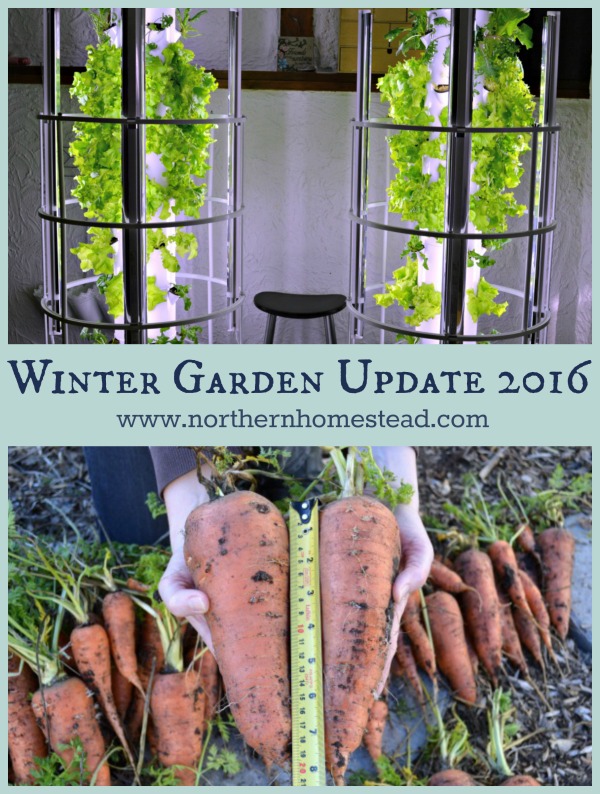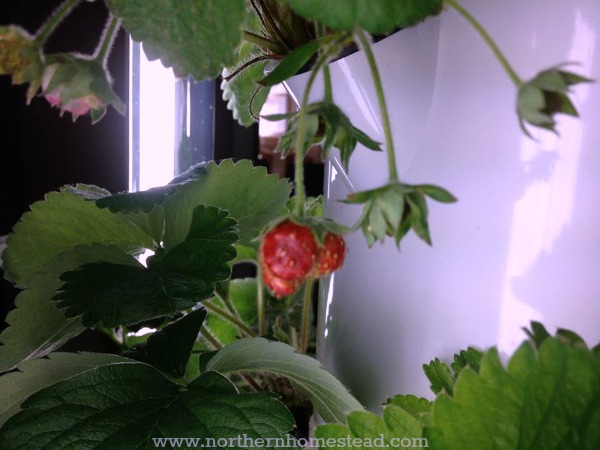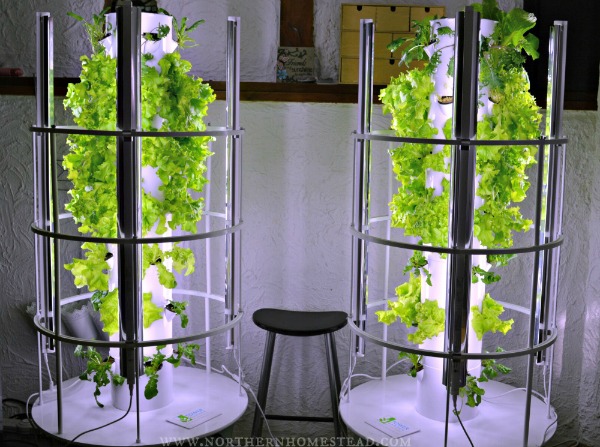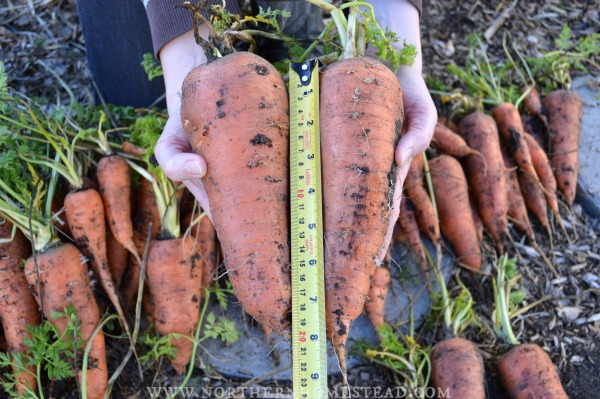
Spring is here, and we are so excited. But before winter is all gone and forgotten let’s have a quick winter garden update 2016! It was our first winter that we were able to grow all our greens all winter long. We used the hydroponic Tower Garden indoors with grow lights, and loved the fresh leafy greens like lettuce, kale, swiss chard, and herbs. Growing indoors is possible and very rewarding.
We also learned some important lessons, sometimes at a high cost, but hey, education is not free, right?! However, if you learn from our mistakes, it is free learning for you.
Lesson One: Do not take outside plants into the house in the fall
Since we are in Zone 3, winter growing here happens indoors. No matter if it is the house, a grow room, or a well-insulated greenhouse, those are all closed-in rooms. Taking in outside plants can lead to problems. We knew that, but didn’t take it too seriously.

We had a Cabbage growing the Kratky Hydroponics way. It did very well, but since it got really cold I had to decide to bring the plant in instead of throwing it away. To bring in a plant in a pot is not a big deal, the only problem was, it had some aphids on it. It was sure an experience, but honestly, not worth the trouble it created.
First, we noticed that the brought-in aphids multiplied rather quickly and we had to learn to live with them all winter long.
We learned that aphids do not like all plants alike. They prefer herbs, and plants from the cabbage family. Arugula and China Cabbage were not possible to grow because of the aphids, they would just take them over. Herbs like dill, basil, and parsley were challenging too. Since we grow hydroponically in the Tower Garden, it was helpful to grow those aphids-loving plants at the bottom, so the aphids would not fall onto other plants like lettuce.

The cabbage was not the only plant we had brought in. We also brought in some strawberry plants to have an early start for those yummy berries. Strawberries do grow well hydroponically in the tower garden. Strawberry flowers are self-fertile and can pollinate themselves.
A real tricky situation arrived with spring. Along with our first ripe strawberry, a whole family of spiders arose on them. As you know, spiders count their children not one by one but by hundreds. I’m not a fan of aphids, but spiders in our house is a big no no. We do not know how these spider babies came in, maybe as an egg bag at the base of the plant. What to do? We decided that we didn’t want early strawberries after all. It was a sad day to put all those healthy plants into a garbage bin. Lesson learned!
Lesson two: Do not overplant an indoor garden
Planting too many plants into one pot is not a good idea at any time. But it seems like an indoor garden is even more sensitive. After all, we cannot create a natural environment indoors. Avoiding any additional stress for the plants is crucial. Planting plants too close together does create stress for plants.

In January we added two more Tower Gardens to the one we already had. At first, we were thrilled to see how well all the lettuce grew on the towers. I pruned back one Tower to just two plants per net pot, but let the second tower grow with 3 and more plants per pot. We soon realized that even two plants in one pot were too many. Growing one plant in one net pot is best.
Soon the multiple plants in one net pot tower were helplessly overgrown. I couldn’t even get the roots out by taking out the plants. We had to take the Tower apart. It was an important lesson, even in a hydroponic garden, there is a danger to overplant. Lesson learned!
Overwintered carrots
We also had overwintered carrots in the garden. Last year it worked very well. However, weather-wise this year was very different. We had very little snow, and it was unusually warm for our Zone 3. I was worried that the carrots would start rotting away under the cover of straw and tarp.

We were relieved to find a nice carrot harvest this March. Because of the temperature, some carrots looked like they had started (or had not stopped) growing. They had many roots on them. Still, they taste really sweet, just a little more dry than the fall carrots.
We had left in the ground Bolero and Danver carrots. The Bolero did better for overwinter carrots, the Danver had some signs of frost on them. Overall we are very happy with the results. Read more about growing and harvesting carrots at Growing Food – Carrots.
Now that spring is here, we are busy with starting plants from seed and getting ready for a new growing season. You can find all our posts and How-tos on Growing here.
Don’t forget to subscribe to Northern Homestead and follow us on Facebook or Pinterest for the latest updates.


I live in Minnesota and I attempted to over winter some of my carrots and when I dug them up earlier this week they were very mushy and no longer in a solid form. Is there something special I have to do in the fall to help them survive the winter? Thanks.
Sorry to hear this happened to you. It sounds like your carrots got some frost during the winter. Choose a location for the carrots with covering them for winter in mind. One where the snow accumulates anyways is best. If there is a blizzard carrots need extra protection and snow is the best insulation in addition to the straw. Hope this helps.
I have a sun room and decided to over winter some out door plants. Didn’t go in except to water from time to time and had a HUGE surprise when I opened the door to a big black cloud of gnats! Billions and billions of gnats! All I could do was slam the door shut and put on a shower cap, goggles and go in with a shop vacuum. Four times a day for several days I went in to vacuum while trying an organic bug spray and after a week of this I finally gave up and had to take in a bug killer I’m not fond of using. If I ever do this again everything gets a shower, top soil and leaf spray down of bug killer and pot and under pot a dip- wash in bleach.
Thank you for sharing Sheri! It is so tempting to take plants in, and usually the bugs are not visible as long as the plants are outside. They hide well. Glad you got them under control though. I too do not like bug killers, but sometimes there is no other choice.
I brought in an onion that hadn’t grown very big in the outdoors last fall and planted it in my window box. It got some crinkly looking spots on the leaves, which is strange for an onion, so I looked closer and found a lot of wee little white, crawly bugs all over the onion. I’ve never had them in my window box before and they were getting onto some other onions too (green onions), so I quickly uprooted the onion that they were coming from, squished any and every one I saw for the next couple of days, decided that wasn’t good enough, and harvested everything that was growing in there. I treated the soil with lavender vinegar and left it for a while. I’ve got lettuce in there now and it seems to be doing fine. No more white bugs as far as I can tell.
Glad you were able to get rid of them. It just shows again, that bringing in plants is not worth it. Thank you for sharing!